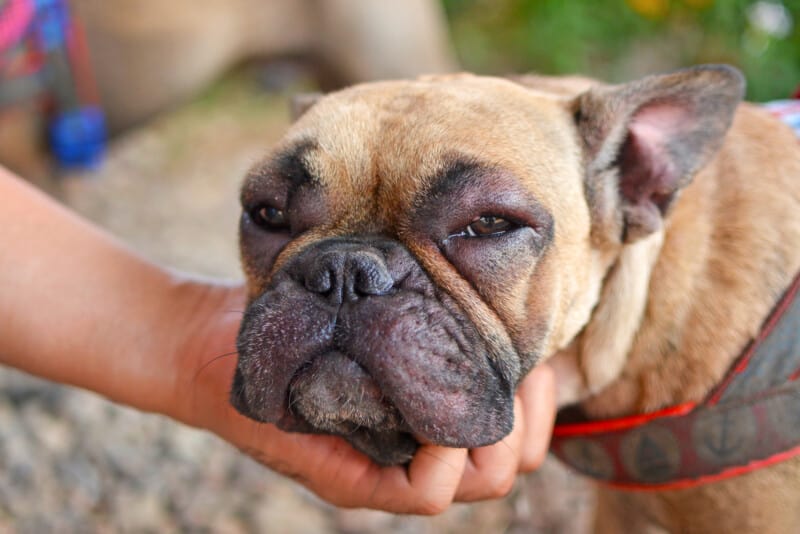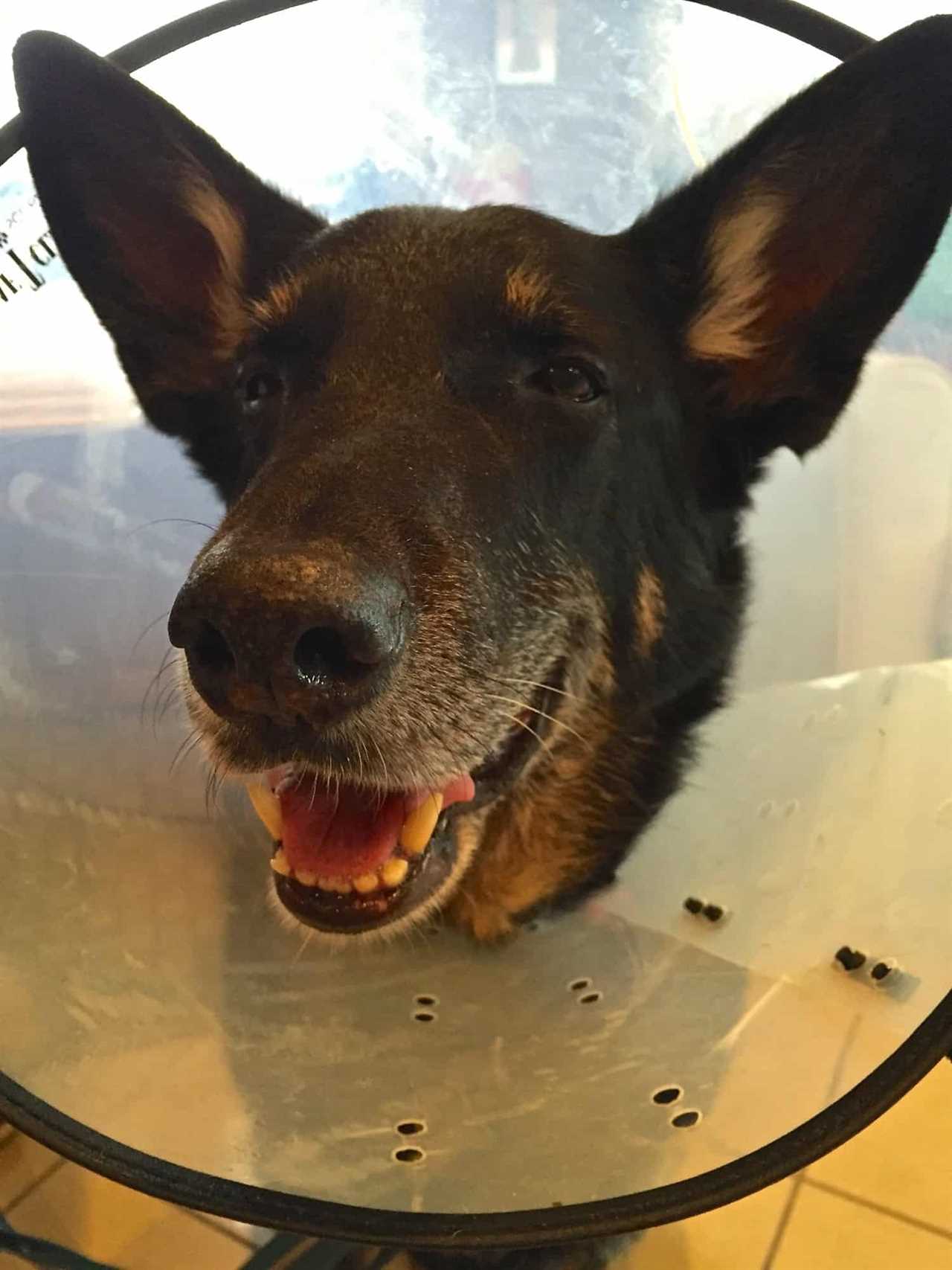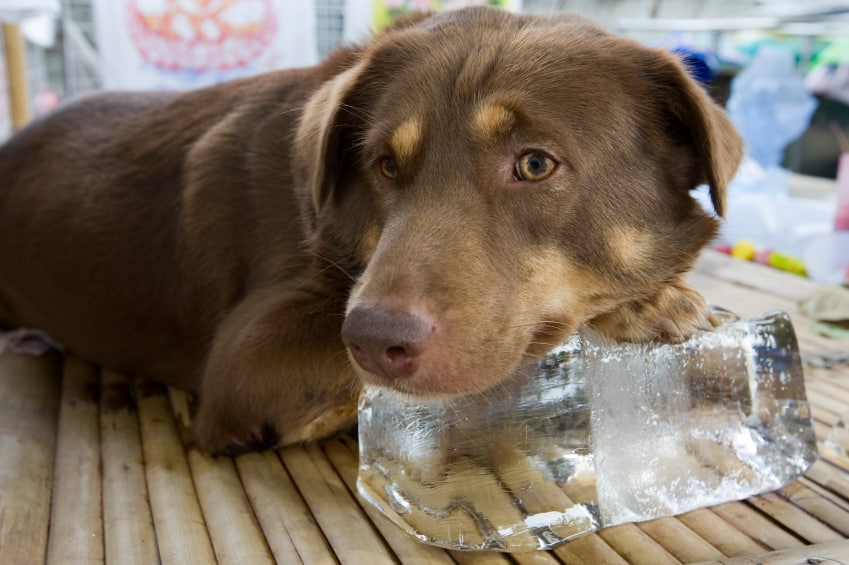Exploring new places with your pets often includes spending time outdoors. And being out in nature means you’re more likely to run into stinging insects. In this post you’ll learn what to do if your dog or cat is stung by a bee.

No one likes being stung. At the very least, it’s going to be uncomfortable. And because dogs and cats can have allergic reactions similar to humans, being stung by a bee can be a serious concern. Fortunately, there are some steps that you can take to help keep the bees at bay.
Avoid Confrontations
The safest strategy is to avoid a tangle with the wrong insect … though convincing your pets to cooperate can be difficult! So, it’s important to take some precautions to help your dog or cat stay away from bees.
Start in your yard by growing plants like chrysanthemums, lemongrass, or primrose, which don’t attract bees. When you and your pet are outside, burn citronella candles and don’t leave food outdoors. And make sure you’ve trained your dog to “leave it” whenever he’s tempted to put his nose where it doesn’t belong.

Your Dog Or Cat Has Stung By A Bee – Now What?!
Still, even if you take all the precautions, accidents happen. Pets can be stung on the face, inside the mouth, on their paws, or on other parts of their bodies if they snap at, sit on, or step on a bee. So it’s best to be prepared!
How To Tell If Your Pet Has Been Stung
If you don’t actually see your dog cat get stung by a bee you’ll need to look for other clues of the encounter. Check for swelling, pawing at the face, or obsessive licking. These are signs that your best friend has met business end of a stinger.
If you notice these symptoms, you’ll need to watch your pet carefully for the next few hours. Some animals, like some people, are highly sensitive to insect toxin. In those cases, your pet could experience Anaphylactic Shock, a severe allergic reaction which can cause the circulatory system to shut down.
READ MORE ⇒ What You Should Know About Emergency Vets (Before You Need One)

Signs Of A Serious Allergic Reaction To A Bee Sting
If you notice any of the following symptoms, which usually occur within an hour of the sting, DO NOT DELAY in getting veterinary care:
1. Severe and profuse swelling (i.e. entire face as opposed to just the lip)
2. Difficulty breathing or increased respiratory effort possibly due to throat swelling
3. Very pale or blue-tinged mucous membranes (inner lips and gums)
4. Rapid and/or irregular pulse
5. Prolonged Capillary Refill Time (Refer to “Checking Your Pet’s Vital Signs,” but if gums are pale, or if it takes longer than 2 seconds for the color to return to the gum when pressed with your finger, your pet needs immediate medical care.)

Treating Your Pet’s Bee Sting
Even if your pet doesn’t appear to be having a severe reaction, the sting might still be painful. Keep a close on him while you gather the following items:
- Cold Pack
- Baking Soda or Meat Tenderizer Containing Papain
- Epi-pen, if your pet has had previous encounters with bees and is known to be allergic
- Water
- Syringe, Eye Dropper, or Spray Bottle
- Diphenhydramine/Benadryl® (Note: The product you purchase should contain diphenhydramine as the only active ingredient. Some products contain additional pain relievers and/or decongestants that can be harmful to pets.)

Depending on where your dog or cat has been stung by bee, there are some steps you can take to help speed their recovery.
IF THE STING IS INSIDE THE MOUTH:
— Offer your pet an ice cube or small amount of ice water to minimize swelling
— Seek immediate advice from your veterinarian, as the mucous membranes of the mouth will more quickly absorb the insect toxin. Should your pet’s tongue swell, giving rescue breathing might be impossible, and a veterinarian will be best equipped to help.
IF THE STING IS ELSEWHERE ON THE BODY:
The stinger might be concealed in your pet’s fur, or it could already have been pawed away. But if you can see it, flick it away with a credit card, popsicle stick, or your finger nail. Do not pull the stinger with your fingers or tweezers as you can puncture the poison sac, allowing more toxin to enter your pet’s body.
If you have an epi-pen prescribed specifically for your pet due to previous allergic reactions, read and follow the attached instructions. Follow up immediately with your veterinarian as anaphylaxis can occur.
If you can locate the sting site, dab it with a paste made from 1 Tablespoon baking soda or meat tenderizer mixed with a drop of water. (Meat tenderizer and baking soda are both alkaline and work to counteract the acidity of the toxin. Also, the papain in tenderizers breaks down the protein in the toxin.)
Administer diphenhydramine (Benadryl® antihistamine). While this medication is generally considered safe for cats and dogs, consult with your veterinarian to determine the proper dosage. Also discuss any other medications your pet is taking and any pre-existing medical conditions. Diphenhydramine will help relieve mild allergic reactions and make your pet sleepy, allowing him to relax and prevent him from scratching the sting site. If swelling persists for more than 6-8 hours, consult your veterinarian for further treatment.
Apply a cold pack to reduce swelling, but remove every few minutes to avoid frostbite. Placing the cold pack in a damp washcloth will help keep your pet’s skin from getting too cold.
Homeopathic Tip: Apis Meliffica, also known as Honey Bee, can aid the body in reducing the burning or stinging pain.
READ MORE ⇒ How To Tell If Your Dog Has A Fever

Preparations For Traveling With Pets
Of course, bee stings don’t always happen when you’re at home. So make sure the items you’ll need to treat a bee sting are in the first aid kit in your car and in your hiking backpack.
Also, if your pet is too large to fit into your backpack, consider getting an emergency sling (affiliate link) that would allow you to carry him back to your car.
Being prepared allows you to give your pet the attention he needs quickly. And the sooner he’s better, the sooner you can both get back to having fun.
READ MORE ⇒ Make A DIY Pet First Aid Kit For Your Car


About the Author: Denise Fleck has trained with 12 national animal organizations and has taught more than 10,000 pet lovers animal life-saving skills. She’s developed courses, written nine books, and created a line of pet first aid kits and posters so people can help their pets BEFORE veterinary care can be reached.
The post What To Do If Your Dog Or Cat Is Stung By A Bee appeared first on GoPetFriendly.com.
-----------------------------------------------------------------------------------------------------------------
By: Guest
Title: What To Do If Your Dog Or Cat Is Stung By A Bee
Sourced From: www.gopetfriendly.com/blog/what-to-do-if-your-dog-or-cat-is-stung-by-a-bee/
Published Date: Wed, 25 Oct 2023 09:30:00 +0000






